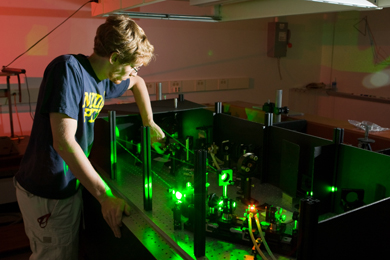Apr
18
Light has been thought of as being only photons and waves – no magnetic energy of significance available or worth the effort. The knowledge of the magnetic component has been there, but the conclusion of decades ago, persistent education, and just following along has dulled the minds of generations.
So when University of Michigan researchers revealed last week a dramatic and surprising magnetic effect of light discovery that could lead to electric solar power production without traditional semiconductor-based solar cells – heads turned. There may even be some denial if one looks around a bit.
Stephen Rand, a professor in the University of Michigan departments of Electrical Engineering and Computer Science, Physics and Applied Physics said, “You could stare at the equations of motion all day and you will not see this possibility. We’ve all been taught that this doesn’t happen. It’s a very odd interaction. That’s why it’s been overlooked for more than 100 years.” Congratulations on the find, Professor.

Light Magnet Lab Bench Research Setup. William Fisher, a doctoral student in applied physics, performing research on laser-induced magnetism. Image Credit: Univerity of Michigan.
The pair as Professor Rand puts it, found a way to make an “optical battery’, a curious sort of analogy explained below. But, this adds up to an overturned century-old tenet of physics. You have to love these moments when the universe is still in part an undiscovered place with mysteries to find and explore.
As just mentioned light has electric and magnetic components. To date scientist thought the effects of the magnetic field were so weak that they could be ignored. But Rand and Fisher found that when light at the right intensity is traveling through a material that does not conduct electricity, the light field can generate magnetic effects that are 100 million times stronger than previously expected. Under these newly discovered circumstances, the magnetic effects develop strength equivalent to a strong electric effect.
Fisher explains that what makes this possible is a previously undetected brand of ‘optical rectification’. In traditional optical rectification, light’s electric field causes a charge separation, or a pulling apart of the positive and negative charges in a material. This sets up a voltage, similar to that in a battery. This electric effect had previously been detected only in crystalline materials that possessed a certain symmetry.
Rand and Fisher found that under the right circumstances and in other types of materials, the light’s magnetic field can also create optical rectification.
“It turns out that the magnetic field starts curving the electrons into a C-shape and they move forward a little each time,” Fisher continues. “That C-shape of charge motion generates both an electric dipole and a magnetic dipole. If we can set up many of these in a row in a long fiber, we can make a huge voltage and by extracting that voltage, we can use it as a power source.”
The light must shine through a material that does not conduct electricity, such as glass. And it must be focused to an intensity of 10 million watts per square centimeter. (That’s the catch, for now.) Sunlight isn’t this intense on its own, but new materials are being sought that would work at lower intensities, Fisher offers.
“In our most recent paper, we show that incoherent light like sunlight is theoretically almost as effective in producing charge separation as laser light is.” Fisher said.
The team predicts that with improved materials they could achieve 10 percent efficiency in converting solar power to useable energy. That’s equivalent to today’s commercial-grade solar cells. Keep in mind though; the product is direct magnetism, the ‘precusor’ if you will allow, for power generation.
“To manufacture modern solar cells, you have to do extensive semiconductor processing,” Fisher points out. “All we would need are lenses to focus the light and a fiber to guide it. Glass works for both. It’s already made in bulk, and it doesn’t require as much processing. Transparent ceramics might be even better.” It’s likely not that simple, but the micro production and costly silicon production processes would not be needed over huge areas.
Experimentation will continue this summer at UM and the University is already at work pursuing patent protection for the intellectual property.
One’s imagination is at near turmoil with the implications. Rand says from a very early perspective, “This could lead to a new kind of solar cell without semiconductors and without absorption to produce charge separation. In solar cells, the light goes into a material, gets absorbed and creates heat. Here, we expect to have a very low heat load. Instead of the light being absorbed, energy is stored in the magnetic moment. Intense magnetization can be induced by intense light and then it is ultimately capable of providing a capacitive power source.”
Which is not to say you can’t go ahead and use the light again in a photovoltaic cell.
A few moments thought about the future possibilities in electronics alone coax a shiver. This is very early major news.

